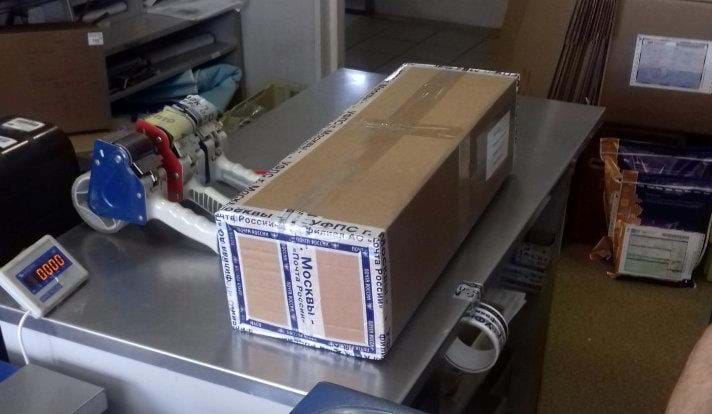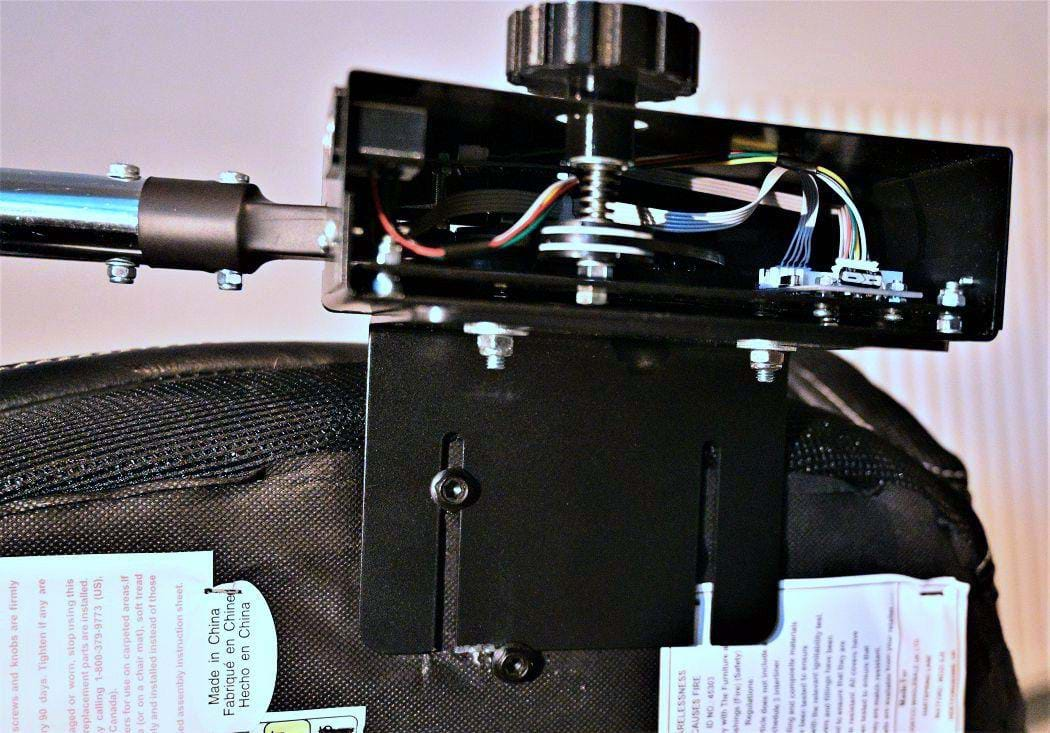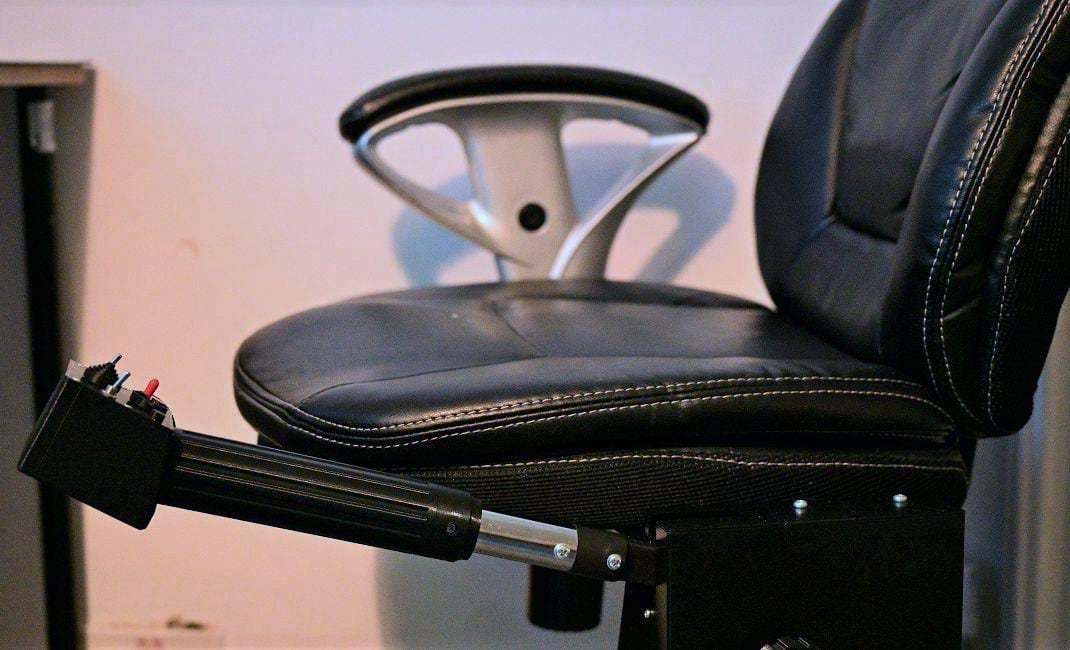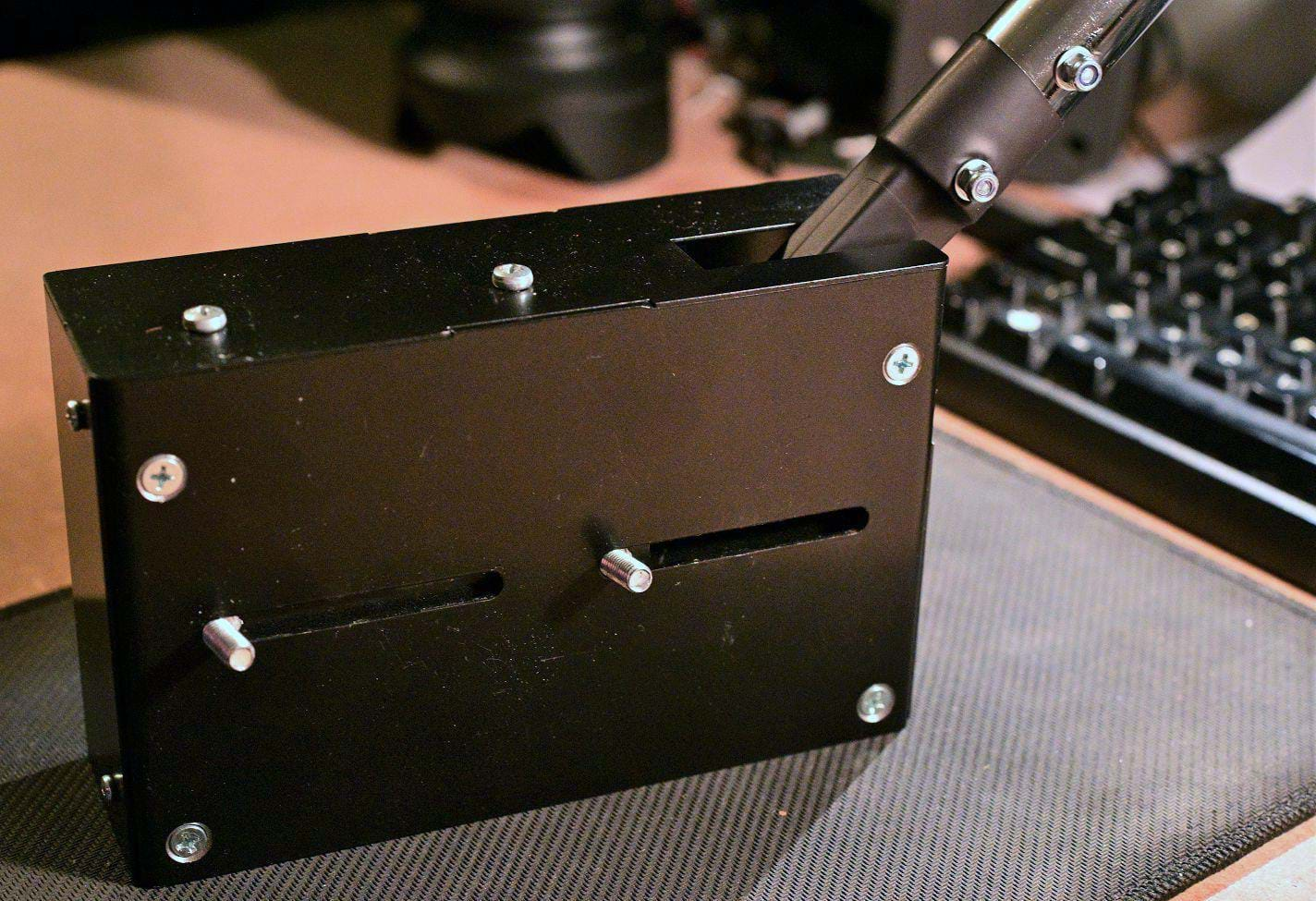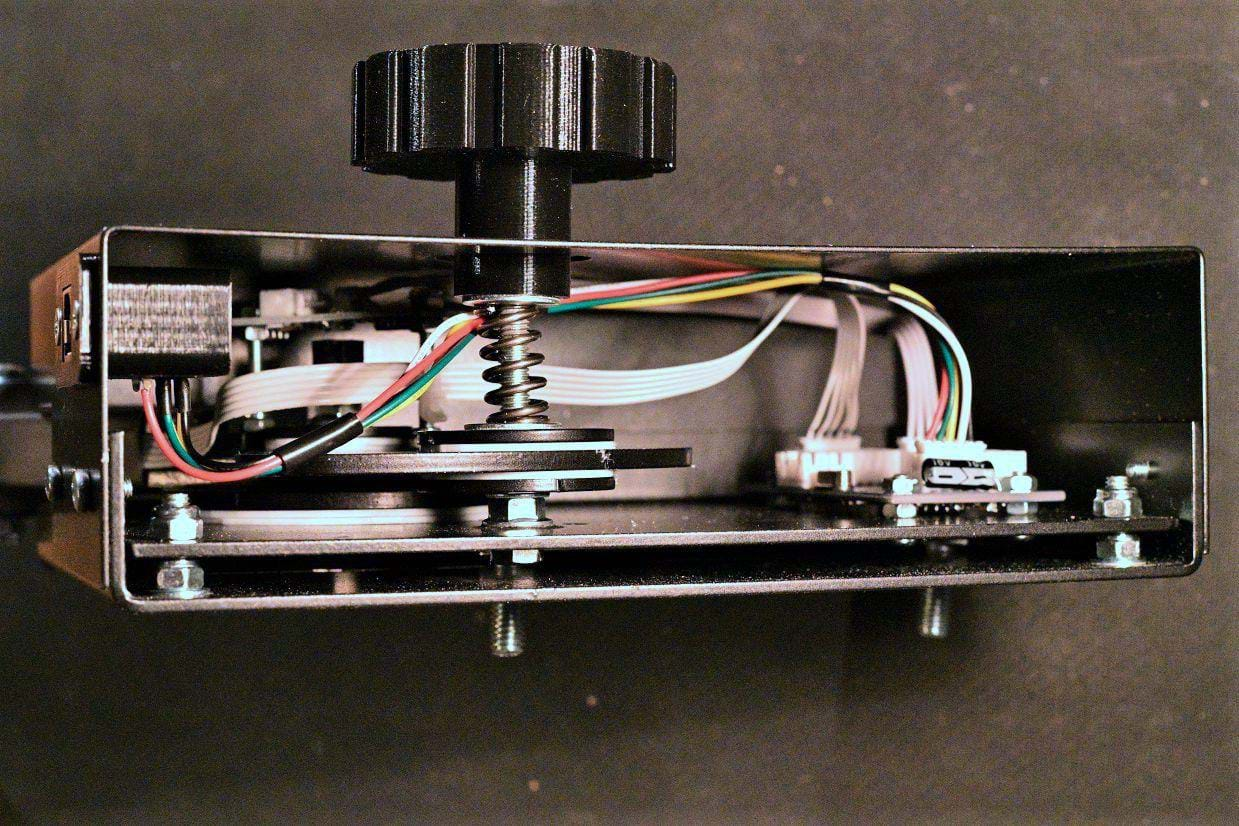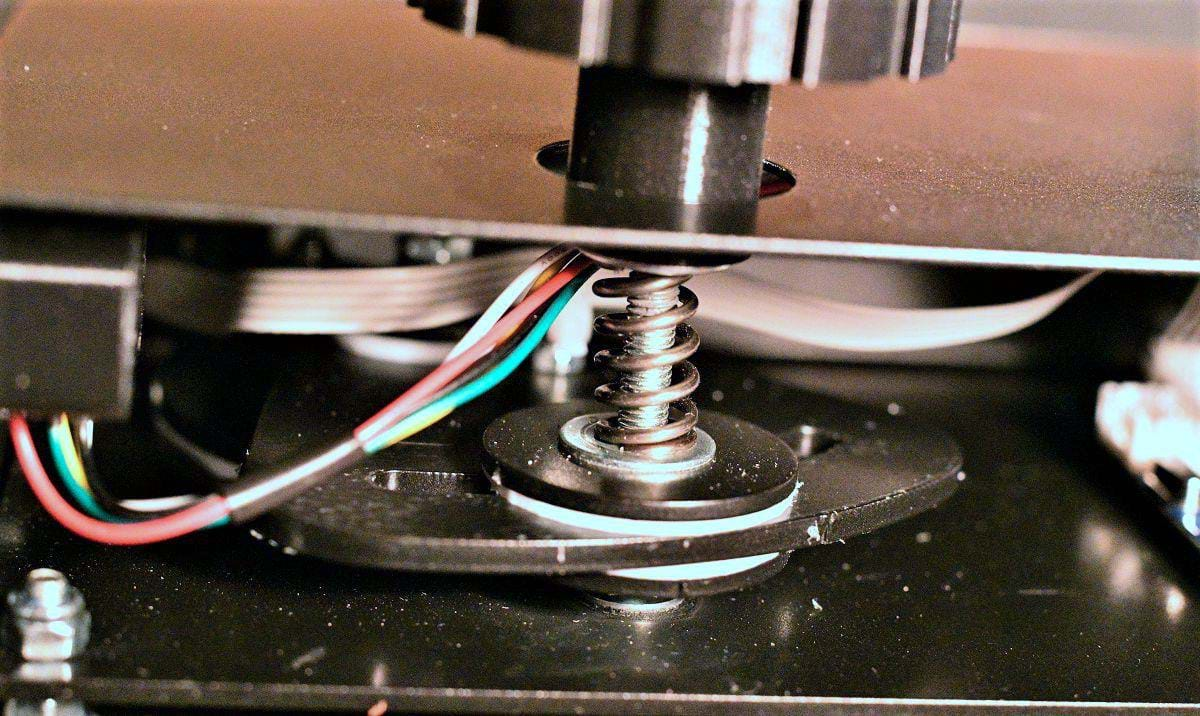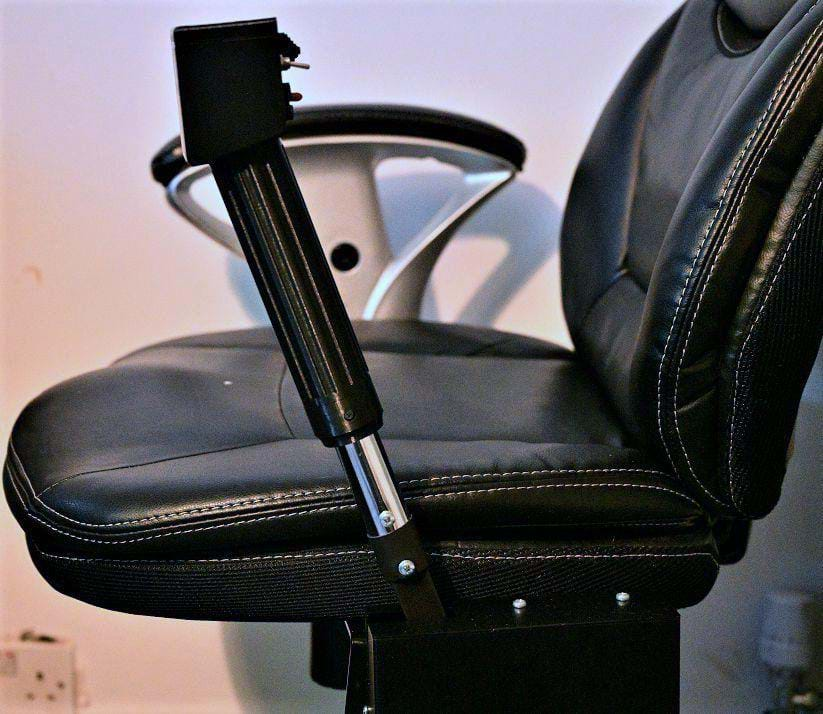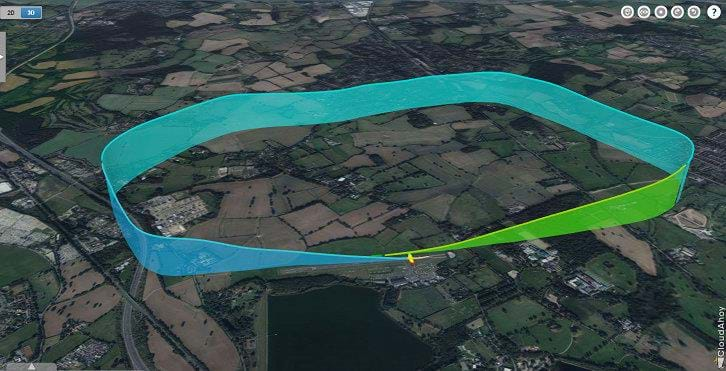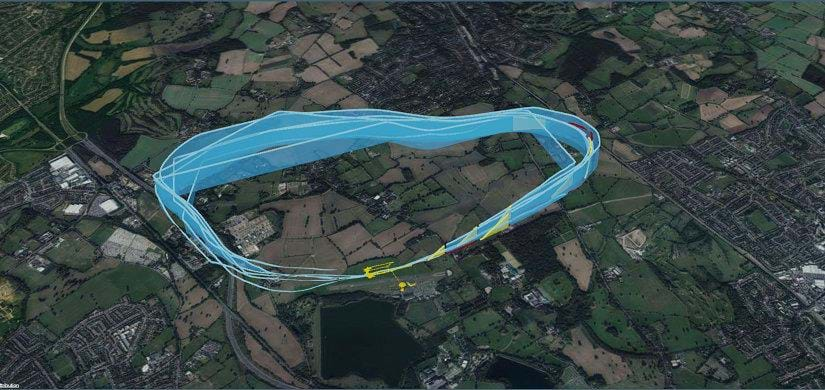Collective use by flight sim fans tends to be rare. Lower numbers of dedicated heli-simmers means that any commercial peripherals aimed at them will be priced far too high for casual consideration if the product is to be economically viable for any mainstream manufacturer.
The only low-cost option for simmers wanting a device that they could use to accurately replicate one of the mechanical processes of helicopter piloting was to build their own. This has typically been limited to those of us with both the time and technical skills to combine parts from many different suppliers or design and craft their own.
Basically, you needed to be either loaded or a nerd.
The K-51 collective is the first real challenge to that idea that I’ve come across.
Why use a collective?
Many people have very successfully used their HOTAS throttle to perform the role, just as many of us started using their joystick’s twist axis to emulate pedals. So, why bother adding yet another peripheral?
Unlike a HOTAS press-ganged into the role, a dedicated collective answers challenges of fine control due to its longer lever arm, and ergonomics and comfort due to the typical location, however this is outweighed by the two following arguments against using one.
In my opinion the two primary reasons for people not using a dedicated collective peripheral has been the historical pricing and availability.
For instance, the two products I’ve been watching closely while I tried (and failed) to save the money for them have been those offered by Komodo Sim in the UK and MicroHelis in Germany.
At £940 (£445 (~US$550 at the current exchange rate) for the UH-1H grip and £495 (~US$620) for the base) and €589 (~US$650) for the basic UH-1H respectively, these are incredibly prohibitive prices for most of us.
Looking at the sites indicates that there’s also an 8 to 12 weeks turnaround for a Komodo Sim product and around a month for the MicroHelis product.
Make no mistake: both manufacturers offer incredibly well designed and accurate devices that mimic their real-world counterparts very closely.
If the twin issues of historical pricing and availability are to be overcome, then there are one or more things that need to happen for dedicated collectives to become more popular amongst simmers:
- The price will need to drop drastically, which will typically require a drop in quality, or reduction in features.
- The build will need to be simple enough to build enough of them to justify reduced profit margins.
- They need to be happier with lower profit margins or not need to pay employees as much (i.e.: be self-employed).
The K-51 collective comes in at an unbelievable £205 (US$220 / €200) with delivery to my UK address.
At almost 5x cheaper than the Komodo and less than half the price of a Micro-Heli device how much of a reduction in quality and features will have to be made?
Let’s break it down.
First impression
I originally contacted user K-51 (real name Mikhail) over at the Eagle Dynamic forums, and at first glance from the posts saw a rudimentary collective that looked like it was mostly 3-d printed material and had enough buttons to cover most requirements in DCS and X-Plane.
The price was too good to let go though, so I decided to give it a shot. It would likely be cheaper and faster than me trying to build one.
I put in my order and a day later he sent me a picture of the product waiting to be mailed.
The box on the packing table was exactly how it arrived.
I was also sent a copy of the mailing receipt and a tracking number.
Then the Covid-19 lockdown happened, and it languished in a Moscow postal and customs house for a few weeks.
After about a month after the order, the box arrived. And, suddenly, jokes about Russian durability aren’t funny anymore. Mikhail is fastidious about packing his product safely!
A good knife is required to open the box and then get further into the tightly taped Styrofoam.
There is no shifting of the items in the box. In order for that to happen there needs to be space, of which there is none. His Styrofoam inner needs to be pushed back into the box because it’s so snug.
Then came the bubble wrap. Not too much but enough to protect any over-eager attempts to open the outer packaging and accidentally scratch the item.
When it’s free from its cocoon, you’re left holding the collective and the USB cable. Two pieces, no tools, no other accessories, no instructions.
But that’s not bad news. Not at all.
Assembly
Plug the cable into the collective.
That’s literally it.
The Type-B USB side goes into the collective, the other end obviously fits your PC. No other items to add, no covers, grips or anything else.
The mount plate is designed to be the same dimensions as the collective base so that it can be bolted to it and not increase the overall size when packed. Two thread-locked bolts remove it, and you have a variety of mounting methods using the slots.
The bolts to attach the mount to the base are very cleverly kept on the base, inside a sliding frame that keeps them perfectly spaced for the plate’s mounting slots. The mount itself has two slots that are open at the edge, easing installation or removal from wherever you choose to place them.
This lets you slide the unit up and down and forward/backwards.
Installation
There are two slots for mounting the unit to a surface or chair. No fixed pattern, or individual holes like many sim HOTAS products.
You can get by with just two bolts, or even a set of four if you’re a bit paranoid about it not coming loose.
For my review I was in a bit of a pinch. I’m in the middle of a house move/build and so I’m currently in the attic with my Playseat packed away.
I had to use an office chair but because of Mikhail’s mount design it was a doddle to set up. I simply unbolted one arm and used the existing bolts to secure it in the space left behind.
Fortunately, the bolts are of thick enough steel to take the weight and torque, and the mounting plate is thick enough to not bend when used and mounted only at one point. I guess that was a decent way to test durability, although it wasn’t my intention.
Using the two bolts mounting the plate to the base I was able to level it to my satisfaction, and set it to a height that was comfortable with the collective lever next to my thigh when at its lowest position.
Setup
Mikhail provided me with simple instructions, assuming a basic understanding of configuring a joystick for use with DCS.
Basically, plug it in.
He also sent a link to his firmware, VIRPIL Software Setup, and a few illustrations of the curves he uses.
What could go wrong? It’s been bulletproof so far!
Well the typical attitude of a flight simmer is “new is better” so I promptly downloaded a new version of VIRPIL’s software and clicked “Yes” when asked if I wanted to update the firmware.
Which promptly rendered the collective unresponsive. Evidently, he’s very serious when he says “Use this particular version of the program.”
A couple of emails later and I’d fixed it by using an older version of the VIRPIL Software Setup (Ver 20200204) and using the firmware held by that program.
I loaded the profile he’d linked to me earlier and it was as good as new.
Why is he using VIRPIL software? Well, that’s because he’s actually got VIRPIL electronics installed!
When it comes to the components and sensors, he definitely hasn’t cut any corners.
All the fiddling with the VIRPIL Software Setup was unnecessary, I realised later, because upon firing up DCS the software recognises it immediately. Unplugging it and plugging it back in simply makes it disappear and reappear in DCS configs. No restart needed.
Further setup in DCS is just like adding a joystick or other device. Simply map the axes and button functions you wish to use in the aircraft you prefer.
I also tried it in X-Plane 11 with the same results. It was automatically detected, and I was only required to tell X-Plane what I wanted the different buttons to do. I also had to invert the throttle.
No need to find the button numbers in the setup software, simply clicking the button or using the axis took you straight to that option in the menu for you to edit, just like any other good device.
I’m running it through a USB 3.0 hub, that is drawing power from the PCs own USB 3.0 socket and it’s sharing the USB hub with VKB pedals, a Gunfighter Mk2 w/ MCG Pro and an X-55 throttle.
I had no issues with power or device conflicts, and I didn’t need to use an external power source for the hub.
Product Details
More good news is that it’s solid. Very much so.
I expected a lot of plastic, it’s mostly metal with some 3-D plastic parts. Put it down less than gently on a solid surface and you’ll get a satisfying “thunk”.
Don’t unwrap this on your glass coffee table or your mum’s nicely varnished dining table.
Don’t drop it on your toe.
The metal base is well machined and appears to have been stamped and pressed into shape. All the bolts have nylon thread-locks. None are stripped or badly fitted.
I could only find one metal “snag”, at the top rear of the base, that might scratch you if you were extremely unlucky. A nail file sorted that out. Minor.
The collective lever is chromed metal, about as thick as your standard bathroom chrome towel rail. This appears to pass all the way up to the button box at the end.
It’s solidly bolted to the actual mechanism, which is also a metal plate, about 3.5-5mm thick.
At the point where it joins the lever, there are several more plates stacked and fitting inside the lever.
The join is cleverly protected by heat-shrink tubing.
The electronics are mounted on metal too, with the cabling very tidy and wrapped in strategic spots. The connecting wires from the USB socket seem to rest on the moving part of the lever mechanism, but more shrink tubing protects it from abrasion.
If you were worried it would easily be resolved by taping it out of the way or unscrewing the USB socket and turning it around.
The lever friction is applied by adding spring mounted pressure to two nylon pads. At minimum friction (where the spring is loose) the lever action is very easy and light pressure moves it smoothly. The remaining pad applies enough pressure to hold it so that it doesn’t drop when let go, unlike many a worn R22 collective does.
The friction mechanism also limits the lever’s movement with the friction tension bolt passing through a groove in the lever friction plate.
Maximum and minimum deflection are when the bolt contacts the ends of the groove.
Without a device to measure the angles I’m taking a guess, but the difference between minimum and maximum lever angles seems to be about 40 degrees.
When dropped to minimum pitch position the lever appears to be 15 degree above the horizontal. The various aircraft in our sims all have different angles, so a longer travel would make the most sense to cater to them all.
If you only fly one aircraft that has a much smaller movement you can overcome that by setting the base with the lever at its lowest position, matching the angle of your chosen ship.
Then, within the curves settings, merely reduce the axis so that it does not impart any more signal once past a certain point. Or vice versa and have the maximum angle of the lever match the aircraft’s maximum with the curve set to only activate when the actual lever is raised to the same height as that in the sim. This was my preferred method when I tested it with the Gazelle in DCS.
That said, 0-100% being the output from the device will deliver even finer control than real life if you apply the full axis to a shorter ranged collective in a sim.
The friction knob would prevent you from easily using the collective in the right hand unless you mounted it to a flat surface and not to the side of your chair or chair mount. Although I cannot think of a single right-handed collective on any aircraft, some of you may prefer it.
You could even invert the throttle action in your sim’s curves to allow easier use and permit the natural wrist roll that revs up the engine when you use the collective for something like an S300 that has no governor.
The throttle is a 3-D printed product. The printing texture on it actually provides a decent grip itself, the plastic is surprisingly non-sweaty when used for long periods and appears to be quite durable.
The handle has grooves running the length of it, otherwise there is no other means to provide grip like on other products or real collectives which use a variety of products ranging from cork (UH-1H), foam (Cabri G2), leather, etc. If you wanted a less synthetic feel, a simple solution may be to wrap it in tennis racquet handle grip tape.
Tolerances seem very tight, with very little gap between the collective’s button box and lower sleeve holding the throttle in place. The throttle moves through roughly 90 degrees of movement. While sitting with the throttle in your left hand, you can reach full throttle from minimum with two quick twists. Not unlike what you would find in the UH-1H.
I found the movement very similar in tension and range to what I was familiar with in the Cabri G2 and Robinson R22 and R44 helicopters. Dropping the throttle for autorotations was nearly identical.
The stops are definite and doesn’t feel like an over extension would occur if you weren’t paying attention and tried to rev up the throttle when it was already at maximum when restarting in a new aircraft.
The button box is where we see the most deviation from the other products mentioned earlier. It does not match the UH-1H, which is the DCS aircraft most closely suited to this collective, due to it having more similar angles and throttle use than when compared to the Gazelle and MI-8.
The switches aren’t “military grade” but fulfil their task. I suspect they’d not survive long in any simpit if you kept hitting them with your foot when exiting.
There are 2x two position switches, a three-position switch which holds each position (so three different “button” values in the config) 3x single press buttons (2 black, one red) and two 4-way hats.
I suspect an enterprising individual may find them easy to swap out should they desire or need to.
The wheel on the pilot’s right of the box is an odd addition to a collective, but once I set it to zoom the view in the sim’s axis settings I was blown away at how intuitive and easy it was.
The large wheel makes fine control of the zoom with your thumb extremely easy during flight. The entire box is printed, but of the same thick plastic as the throttle grip.
There are some markings left over from printing and assembly, but if that’s your greatest gripe you could likely quite easily unscrew it, remove the buttons and switches and make it as smooth as you like.
The plate holding the button is nicely secured with 4 screws. No wondering where any hidden pressure-locks are under the surface should you wish to poke around inside.
Because I mounted it on a swivelling office chair there was a risk of me catching the box on the desk as I got up from my chair and turned it to step away.
I soon learned to raise the collective before doing so.
Testing
As mentioned earlier I tested the collective with DCS and X-Plane 11.
The difficulty was in not trying to compare how the different sims handled the inputs and behaved, but to focus solely on how it felt to use it in each instance.
Once I’d installed it and found the sweet spot in each sim and aircraft’s settings, I found myself ignoring the collective completely and just enjoying myself more than I had before while piloting the rotorcraft. Not quite what I should have been doing to critically review the device, but that in itself is perhaps its own judgement at how well it performed.
If a tool or control doesn’t get in the way of you performing a task or enjoying yourself, it generally meets or exceeds requirements.
I felt right at home and found my hovering (especially at the very low hover) so much more stable. Small inputs found me using my pedals more, as I should do, as torque increased or decreased. Frequently, the advice for simmers it so use curves in the config to make the inputs more forgiving.
Conversely, I actually found myself getting better the more realistic I set the collective in these settings, and soon dropped any input curves.
I had some difficulty when I started to practise autorotations in VSKYLAB’s Cabri G2 for X-Plane when I noticed the throttle wouldn’t change the sim throttle, but soon discovered that it’s a “feature” of the Cabri mod that requires you to switch off the governor in flight if you wish to manually use the throttle.
Twisting it while the governor is on does not override the governor as it does in real life. I mapped the top left toggle switch as on/off for the governor and it worked perfectly.
The other toggle switch quickly went to carb heat which oddly enough the mod does not control automatically like the real aircraft’s FADEC system does.
I was also thoroughly enjoying myself practising quick stops at around 50 feet AGL, which require good coordination with the cyclic and collective to quickly flare to a stop while using pitch to maintain height.
Using my HOTAS throttle had made these impossible to practise without some in-game assistance or dampening of input with curves.
I decided to compare a quick flight around ORBX’s Elstree (one of my local airfields) with a pattern profile I’d flown about 2 years ago, using CloudAhoy. I set up my tablet to use the data from X-Plane and did a quick circuit.
I realize the data from X-Plane to CloudAhoy is much more “stable” than the positional data from the iPad’s own GPS, but the smoothness relative to altitude during my flight with the K-51 collective was readily apparent to me.
Have a look, the sim is top, real flight pattern below (yes, I realize that it’s not a perfect oval, we have to dodge the people who complain so I tried to mimic typical noise abatement pattern):
Swapping to DCS with the Huey, I found myself having a much higher success ratio with my “hot” landings, avoiding the dreaded VRS with much more ease as I transitioned quickly from forward flight to the hover.
Muscle memory starts to kick in very quickly with a collective, and you automatically go to various angles once you find a good profile for your descent in quick landings and autorotations.
I found that turning off “Force Trim” resulted in a much more stable flight for me. Your mileage may vary. The Gazelle felt a lot less “jumpy” than it has been before, and the Mi-8 was an absolute sweetheart to fly. Neither of those two required me to use autopilot, nor did I want to.
The friction of the collective holds just right, obviating the need to add more or keep holding the collective up when you’re flying level.
I’ll be honest and admit that I’ve not enjoyed flying any sim helicopter until I got the collective.
It simply felt “wrong”. This has changed all of that.
Using the various testing software (VPC setup software and JoyTest) I noticed no jitter or ghost signals. Rock solid, like the rest of the build.

